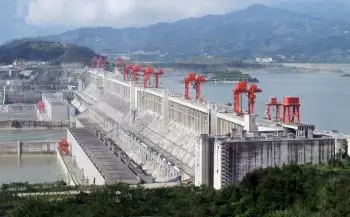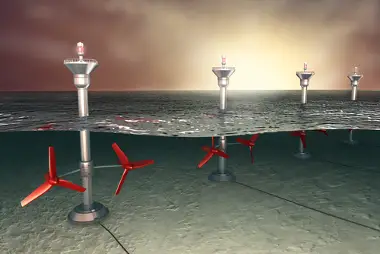
Hydroelectric power is the electrical energy produced in a hydroelectric power station from a water stream, usually from a river.
The construction of dams makes it possible to store large amounts of water and control water flow. In this way, it is possible to produce electricity on demand.
The definition of hydroelectric is the electricity obtained from hydropower.
What are the types of hydroelectric power?
There are different methods to take advantage of the water-energy to obtain hydroelectric energy. Here are the most important techniques:
1. Conventional hydroelectric power plants (dams)
This method consists of constructing a barrier blocking the river flow storing the water is gaining height. When they release water, it falls over a turbine that generates electricity.
The power depends on the difference in height between the water’s level and the turbine. We call the head to the difference in height.
2. Pumped-storage
This method consists of store water pumping it up when there are few demands for electricity. When there is high peak demand, the station release water again to drive the turbines.
In low power demand, excess power generation capacity is used to pump water into the upper reservoir. The goal is to store water so that when demand increases. Then, the plant releases water that falls on a turbine that generates electricity again.
Today, pumped schemes improve the daily capacity factor of the generation system.
3. Run-of-the-river
Run-of-river hydroelectric stations are plants without reservoir capacity, or it is so little. The station only uses the water from upstream at the moment, and in case there was any glut, it must go unused.
A constant water supply from an existing lake or reservoir upstream is a significant advantage when choosing the river flow sites.
4. Tidal power
The movement of water masses can produce electricity in a clean, silent, and renewable way. The main counterpart is its high economic cost.
 This type of renewable energy takes advantage of the tides, making the ocean water rise and fall every day. The main advantage is that this energy source is highly predictable.
This type of renewable energy takes advantage of the tides, making the ocean water rise and fall every day. The main advantage is that this energy source is highly predictable.
If it is possible to build reservoirs, they can also store water to generate hydroelectric power when de demand is higher.
What is the potential of hydroelectric power?
The technical potential for the growth of hydroelectric power around the world is,
-
Europe: 71%.
-
North America: 75%.
-
South America: 79%.
-
Africa: 95%.
-
The Middle East: 95%.
-
The Asia Pacific: 82%.
It is believed that before 2050, 25% of the remaining potential can be developed for different reasons:
-
The political realities of the new reservoirs in western countries.
-
Economic limitations in the third world and the lack of a transmission system in undeveloped areas.
Most of this development would take place in the Asia Pacific area.
Hydroelectric power in the United States is the second-largest renewable energy source in both generation and nominal capacity.
Hydroelectric plants
Hydroelectric plants are hydropower facilities for electricity production.
There are different types of exchanges, but they all have the same basic principle. Take advantage of the power of moving water through a hydraulic turbine. Some of them use a dam to store water at a certain height.
When there is an electricity demand, the water is released from a higher elevation than the turbine. When it reaches the turbine, the water has gained speed and energy, which drives the turbine.
These plants use the mechanical energy of dammed water or the flow of water in a river.
Water circulates through a pipe where potential energy is transformed into kinetic energy. The force of the water rotates the set of turbines, generators, and alternators. Alternators are the ones that generate electrical power.
Depending on the installed power, hydroelectric plants can be:
-
High-power hydroelectric plants: more than 10MW of electrical power.
-
Mini-hydroelectric plants: between 1MW and 10MW.
-
Micro-hydroelectric plants generate less than 1MW of power.
The largest hydroelectric dam in the world is the Three Gorges dam in China.
Mini-hydro plants are those that have an installed power of less than 10 MW. This renewable technology is the most environmentally friendly way to produce electricity, as corroborated by Life Cycle Analysis (LCA) studies carried out for different technologies.
What are the advantages of hydroelectric power?
1. No fuel needed
These stations have the advantage that they do not need fuel to work. The difference in the water height is sufficient to drive the turbines and, thus, the generators. No fossil fuels such as natural gas or coal are used that, in principle, can run out.
Furthermore, no greenhouse gases are released that are held responsible for global warming. Fuel is a substantial cost item in electricity generation. Since a hydroelectric power station uses naturally available water, the fuel costs are nil.
2. Long lifespan
The dams and power stations have a long lifespan.
They can remain in production for 50 to 100 years. Maintenance remains necessary, and they are also being modernized with more effective turbines and generators. Finally, hydroelectric power plants can start up quickly or limit the production of electricity quickly.
What are the cons of hydroelectric power plants?
Nevertheless, there are objections to this form of power generation in nature and environmental circles. The complaints mainly apply to dam power stations.
1. The loss of large areas of soil
The construction of a reservoir is necessary for the construction of a dam power station. The water that is held behind the dam raises the water and floods land. The land is lost as agricultural land, and nature is lost.
The local population has to move to higher ground. New villages have to be built, and people are helped to start a new life. Protests from the local community against the construction of a dam are frequent.
2. Ecohydrological issues
The construction of dams is also causing significant changes because all the energy that a river naturally uses to wind its way through the landscape is concentrated at the dam’s height.
It creates a slow-flowing lake upstream of the dam, and below the dam, there are mainly problems with sediment shortages (erosion) and 'hydropeaking.’
3. Migratory fish
Migratory fish, such as salmon and eel, can no longer enter their spawning grounds due to the dam if they want to migrate upstream. Both eel and salmon migrate through the river in two directions in their life cycle. In the downstream migration, hydroelectric power plants themselves cause significant mortality when fish pass through these turbines.
Systems to make this downstream migration more fish-friendly so that fish are diverted to passages without high-speed propeller blades have proven challenging to implement for the different species.
The most efficient solution to achieve this for all species is a fine-meshed mechanical grid that no fish can pass through.
Hydropower plants with or without a dam are also a migration bottleneck for upward fish migration, which are carried out not only by the large migrators but also by resident fish species, often searching for suitable breeding or growing habitats. Here, fish passages can be useful if they are constructed with expertise. Programs have been started in various countries to demolish mainly old and small dams.
What is the difference between hydroelectric power and hydropower?
The difference is that hydropower can generate electrical energy and obtain energy of another type, for example, mechanical energy.
Hydroelectric power refers only to the use of hydropower to obtain electrical energy or electricity.


